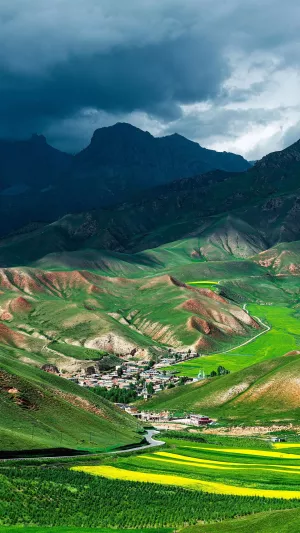Valleys are some of the most striking and common natural features on Earth, formed through the powerful forces of erosion. This process involves the gradual wearing away of land by wind and water over time.
A prime example is a river valley, where the continuous flow of a river erodes rock and soil, carving out the valley.
The shape and characteristics of valleys can vary greatly, often influenced by the type of erosive agent, the slope of the land, the composition of the rock or soil, and the duration of the erosion process. Generally, valleys are categorized into three main types: V-shaped valleys, U-shaped valleys, and flat-bottom valleys.
V-shaped valleys are typically narrow and deep, with steep sides, and are most commonly formed by river erosion. U-shaped valleys, on the other hand, are broader and have a more rounded appearance, often created by glacial activity. Alluvial valleys are characterized by their wide, flat floors, formed by the deposition of sediments over time.
Valleys, with their breathtaking landscapes, inspire awe and evoke a deep sense of tranquillity in those who encounter them. The combination of natural beauty, such as vibrant flowers and lush green grass, creates an environment that feels both serene and revitalizing. Below are some of the most stunning valleys around the world, each offering a unique glimpse into the wonders of nature.
<h3>1. Barun Valley</h3>
Barun Valley is nestled within the majestic Himalayas and is renowned for its spectacular waterfalls, deep canyons, and dense jungle environment. This valley is a haven for nature enthusiasts, as it preserves one of the most pristine ecosystems in the region.
Stretching approximately 27 kilometres, Barun Valley is surrounded by picturesque mountains that soar up to 3,000 meters high. It is one of the few areas in the valley where glaciers exist, providing visitors with breathtaking and unique views that are rarely seen elsewhere. The valley’s lush vegetation and diverse wildlife make it a perfect destination for those seeking to experience the untouched beauty of nature.
<h3>2. Thorsmork Valley</h3>
The Thorsmork Valley, located in the glacier region of southern Iceland, is a strikingly beautiful area where the slow-flowing river winds its way through the valley, eventually meeting the Myrdalsjokull Glacier. Encircled by mountains, this valley enjoys a warmer climate than the rest of southern Iceland, making it an ideal environment for a variety of plant life. The valley is covered with vibrant green plants, including moss, ferns, birches, and other bushes. The Thorsmork Valley offers visitors a peaceful retreat amidst the stunning Icelandic landscape, where the combination of lush vegetation and the nearby glaciers creates a truly unique and mesmerizing environment.
<h3>3. Kalalau Valley</h3>
Kalalau Valley in Hawaii is a secluded natural paradise, surrounded by towering cliffs that reach heights of over 610 meters. Accessible only by foot or helicopter, this valley is a testament to the raw beauty of nature. The frequent rainfall and abundant sunshine transform the valley into a bustling haven of life, with plants thriving on the cliffs and wildlife inhabiting the forests and surrounding mountains.
At the end of the trail through Kalalau Valley, visitors are greeted by a waterfall surrounded by lush greenery, where mangoes, passion fruit, and cherries grow in abundance. This valley is a perfect example of the unspoiled natural beauty that Hawaii has to offer.
<h3>4. Moon Valley</h3>
Moon Valley(Valle de la Luna) is situated in northeastern Chile and is part of the vast Atacama Desert in South America. This region is renowned for its dry lakes and caves, creating a landscape that closely resembles a barren moonscape. Considered one of the driest places on Earth, some areas in the Moon Valley can go hundreds of years without seeing any rainfall. As a result, the valley is almost devoid of wildlife, adding to its otherworldly atmosphere. Despite its harsh conditions, the Moon Valley is a fascinating destination, offering a glimpse into one of the planet’s most extreme environments.
</h3>5. Valley of Flowers</h3>
The Valley of Flowers, located in India, is a stunning natural wonder situated over 3,000 meters above sea level. Covering an area of 87.50 square kilometres, it is one of the most beautiful and serene places in the country. The valley is especially revered by mountaineers and botanists, who are drawn to its vast array of alpine wildflowers. From mid-July to September, the valley is transformed into a vibrant carpet of purple, pink, and blue flowers, creating a truly magical experience for hikers and nature lovers alike. In 2002, the Valley of Flowers was recognized as a UNESCO World Heritage Site, solidifying its status as a place of exceptional natural beauty.
Valleys like these remind us of the incredible power and beauty of nature. Each one, with its unique landscape and ecosystem, offers a different perspective on the natural world, inviting us to explore and appreciate the diversity that our planet has to offer.





